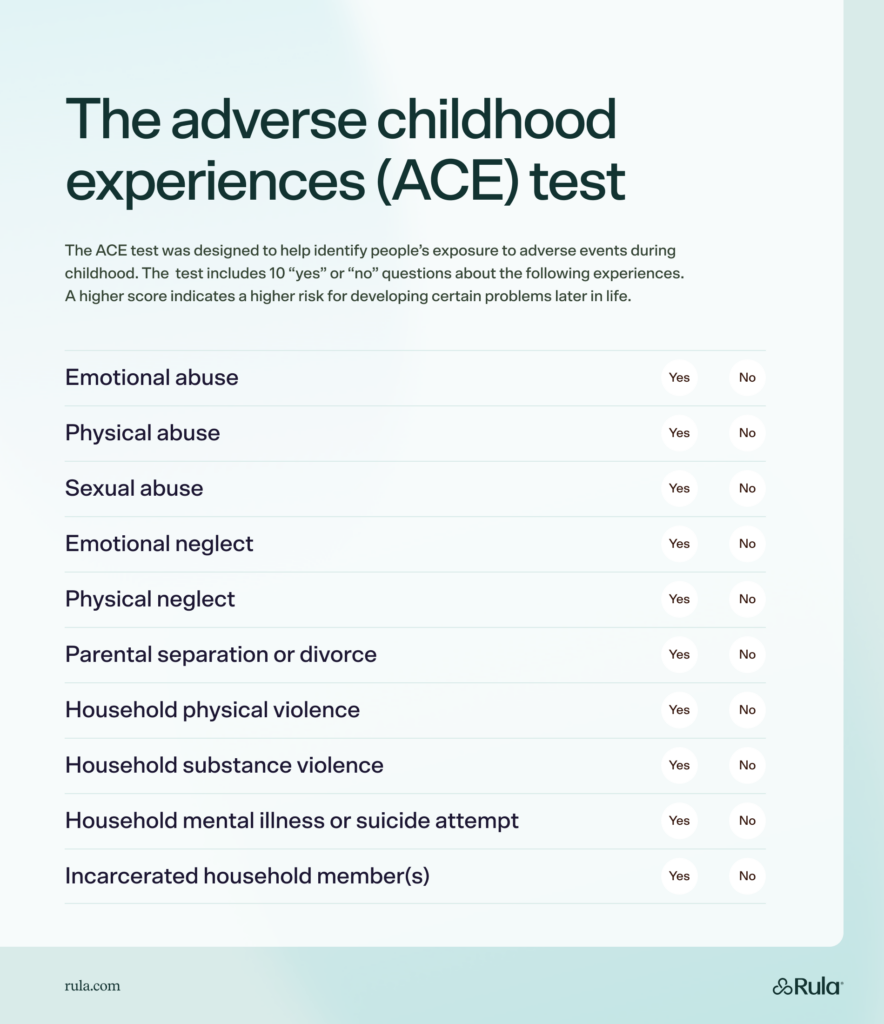Adverse childhood experiences (ACEs) are traumatic events, like abuse or neglect, that occur during childhood. They can have a long-lasting effect on a person’s mental and physical health.
The adverse childhood experiences test is a 10-item tool that providers use to assess exposure to childhood trauma. The higher the number of adverse childhood experiences, the higher the risk of developing certain problems later in life.
ACEs can contribute to mental health conditions, chronic disease, and employment challenges in adulthood. But with resources like therapy and a strong support system, you can learn to manage your symptoms and live a more fulfilling life.
Childhood trauma is any dangerous, violent, or extremely distressing event that affects a person before they turn 18. When discussing childhood trauma, mental health professionals will sometimes refer to the three E’s of trauma: event, experience, and effect.
The event is the actual harm or threat, like being bullied or witnessing abuse, while the experience is a person’s unique perception of that event. The effect refers to the way the event and experience impact a person. For many people, childhood trauma has both short-term and long-term effects on their health, behaviors, and potential for success.
That’s why tools like the adverse childhood experiences test were designed to help professionals identify childhood trauma in adults. From there, people can learn how to process their feelings, manage their mental health symptoms, and improve their overall well-being.
What are adverse childhood experiences?
Adverse childhood experiences (ACEs) are traumatic or potentially traumatic events — like abuse, neglect, and parental divorce — that happen during childhood. Early exposure to adverse experiences can affect social, cognitive, and emotional development in kids. It can also increase your risk of mental health issues, chronic disease, and employment challenges later in life.
Unfortunately, ACEs are common in the U.S., with around 64% of adults experiencing at least one ACE before age 18. Anyone can experience an ACE, but there are certain risk factors that increase your chances of childhood trauma and associated toxic stress. ACEs are more common among children who:
Don’t have a close connection with their caregivers
Are raised by caregivers who don’t have a close connection with others, like friends, neighbors, and extended family
Have a caregiver who doesn’t understand their developmental needs
Have a caregiver who was abused or neglected when they were a child
Are raised in a low-income or low-education home
Are raised in a home with high conflict, negative communication styles, or physical punishment
*_Quiz content written by Lolly Coleman, MS, LMFT._
What is the adverse childhood experiences test?
The ACE test is a short tool that can help people assess their exposure to adverse experiences early in life. It’s based on research from two leading healthcare organizations. These organizations found that people who had adverse experiences during childhood faced a greater risk of mental and physical health problems during adulthood.
The ACE test includes 10 “yes” or “no” questions about the following adverse childhood experiences:
Emotional abuse
Physical abuse
Sexual abuse
Emotional neglect
Physical neglect
Parental separation or divorce
Household physical violence
Unhealthy substance use in the household
Household mental illness or suicide attempt
Incarcerated household member(s)
How does the ACE test work?
The ACE test scoring system ranges from 0-10, with each “yes” response counting as one point. A higher score indicates a higher risk for developing certain problems later in life.
A mental health professional can administer the test, or you can complete it on your own. Either way, it’s important to review the results with your provider. The ACE test isn’t a diagnostic tool, meaning it can’t provide an official diagnosis. But it can help your provider learn more about your unique history and how to best support your mental health needs.
The care you need, when you need it
Learn how Rula can support your mental health journey
Does the ACE test help identify childhood trauma?
The ACE test was designed to help identify people’s exposure to adverse events during childhood. As an adult, you and your provider can use this information to learn more about your past trauma and how the experiences affect your current well-being.
While the test is an effective tool for identifying several risk factors for trauma, it does have limitations. To start, the ACE test doesn’t address stressors outside the home, like poverty, violence, racism, and other forms of discrimination.
The test also fails to acknowledge protective factors, meaning aspects of people’s lives that contribute to positive outcomes. Examples of positive factors include a strong support system, access to education, skill-building opportunities, and financial stability.
Three tips for overcoming childhood trauma
ACEs and other forms of childhood trauma are linked to mental health conditions, substance use issues, and chronic health problems in adults. They can also negatively impact job opportunities and earning potential. But the good news is that it’s possible to manage childhood trauma and create a more fulfilling future with the right resources and support.
1. Try talk therapy
Childhood trauma affects everyone differently, but many people benefit from working with a therapist or other mental health professional. Talk therapy — including techniques like cognitive behavioral therapy (CBT), eye movement desensitization and reprocessing (EMDR), and exposure therapy — is an effective tool for helping people heal from ACEs and other forms of trauma.
2. Create a strong support system
If you’ve experienced childhood trauma, make it a priority to share your feelings and experiences with someone you trust. If you don’t feel comfortable talking with friends or family, consider joining a support group where you can connect with and learn from others who have similar experiences. Sharing painful memories isn’t always easy, but social support and connection can be an empowering part of the healing journey.
3. Focus on resilience and recovery
There’s no predefined timeline for overcoming childhood trauma. In fact, it’s often an ongoing process. Here are a few best practices to help you build resilience, focus on recovery, and improve your overall well-being.
Positive affirmations: Positive affirmations can help you experience less negative thought patterns and cultivate a healthier self-image. For example, “Today I choose me” or “I deserve to be loved and respected.”
Self-care: Self-care may seem like a buzz word, but making time for regular exercise, balanced meals, and restful sleep is an effective way to manage mental health symptoms linked to trauma and stress. It’s okay to start small: For example, take a 20-minute walk each morning, or turn off your phone 30 minutes before bed.
Grounding techniques: Mindfulness and grounding exercises can be useful tools for managing overwhelming emotions and focusing on the present moment. Yoga, journaling, and exercise are other healthy outlets for channeling difficult feelings and emotions.

Find the right therapist with Rula
Overcoming adverse childhood experiences isn’t always easy, but help is available for anyone who is ready to begin their healing journey.
At Rula, our care coordinators will help you find a therapist who takes your insurance, is accepting new clients, and has experience treating ACEs and other forms of trauma. And, if medication ends up being a part of your treatment plan, we can connect you with a psychiatrist to find the right medication to manage your symptoms.
Find trauma and PTSD therapy near you
New York – Texas – California – Georgia – Illinois – Hawaii – Indiana – Virginia – North Carolina – Pennsylvania – Find your city
Rula's editorial process
Rula's editorial team is on a mission to make science-backed mental health insights accessible and practical for every person seeking to better understand or improve mental wellness.
Members of Rula’s clinical leadership team and other expert providers contribute to all published content, offering guidance on themes and insights based on their firsthand experience in the field. Every piece of content is thoroughly reviewed by a clinician before publishing.




